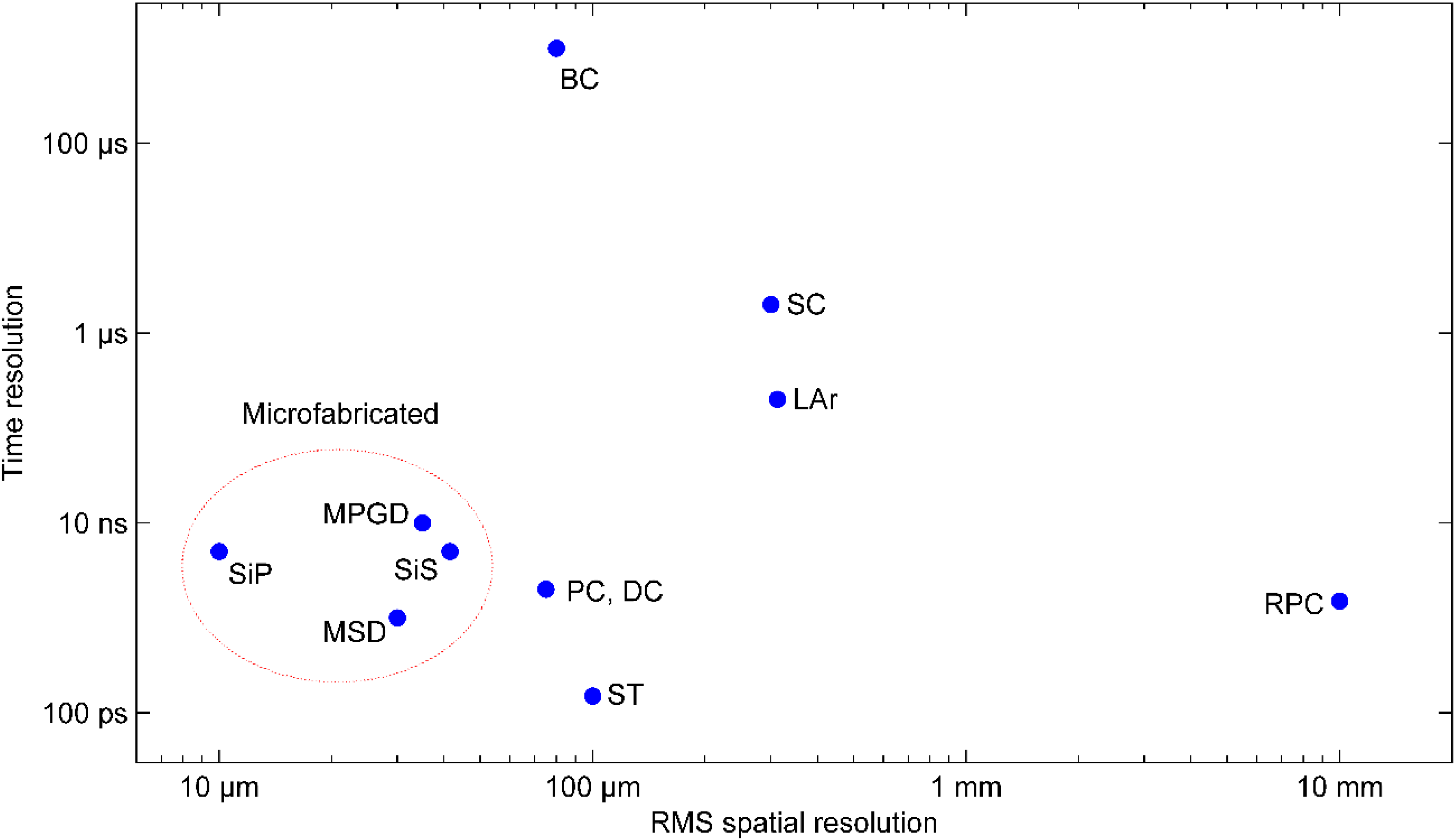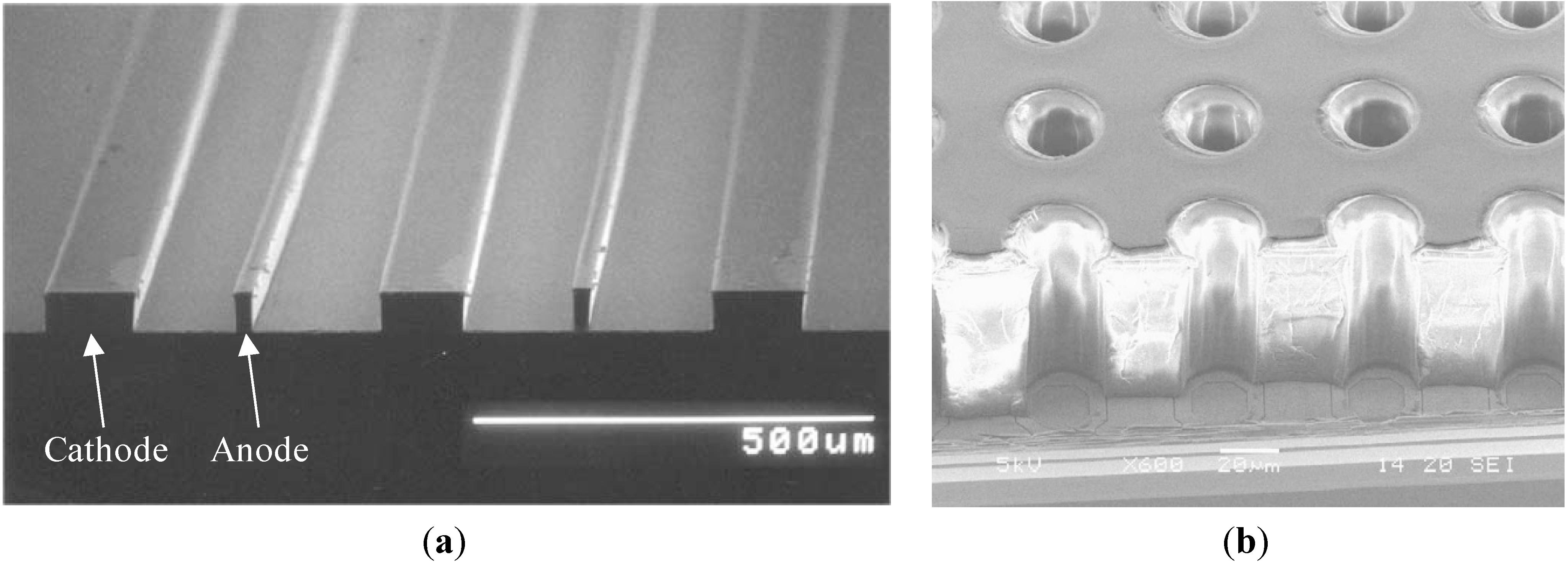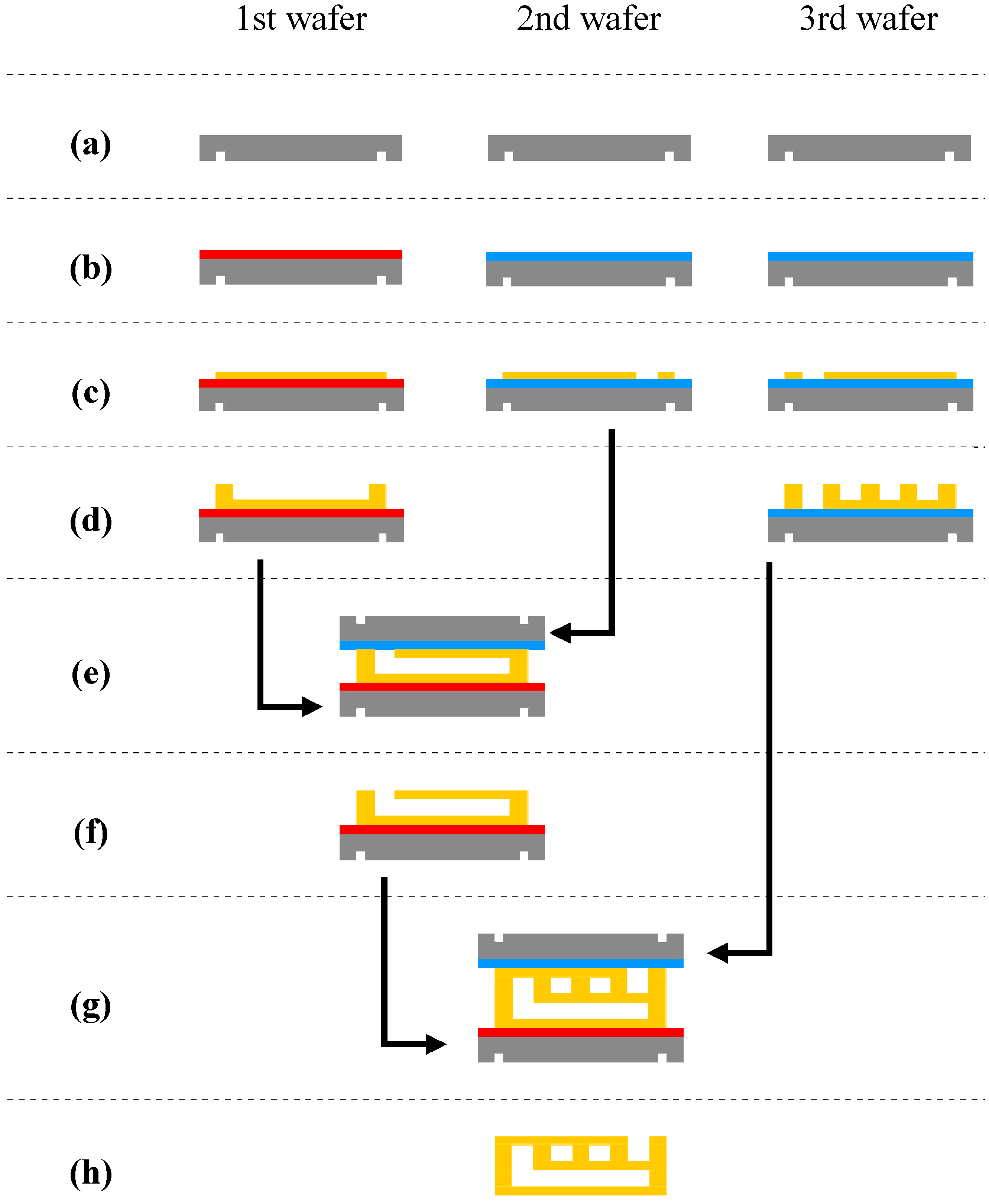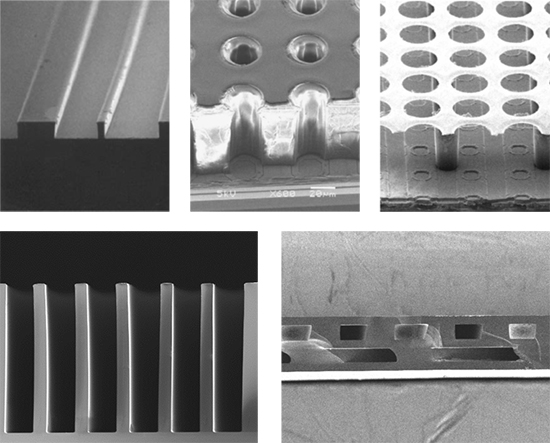SU-8 as a Material for Microfabricated Particle Physics Detectors
Abstract
:1. Introduction

2. Micropattern Gaseous Detectors
2.1. Microstrip and Microwell MPGDs

2.2. Micromesh Gaseous Structure Detectors
3. Microfluidic Scintillation Detectors
3.1. Single Layer Devices

3.2. Towards Two Dimensional Position Sensitivity


4. Applications Overview
4.1. Particle Tracking in High-Energy, High-Luminosity Experiments
4.2. β Autoradiography Imaging and Liquid Scintillation Counting
4.3. On-Line Beam Monitoring in Hadron Therapy
5. Conclusions
Acknowledgments
Author Contributions
Conflicts of Interest
References
- Beringer, J.; Arguin, J.F.; Barnett, R.M.; Copic, K.; Dahl, O.; Groom, D.E.; Lin, C.J.; Lys, J.; Murayama, H.; Wohl, C.G.; et al. Review of particle physics. Phys. Rev. D. 2012, 86. [Google Scholar] [CrossRef]
- Lorenz, H.; Despont, M.; Fahrni, N.; LaBianca, N.; Renaud, P.; Vettiger, P. SU-8: A low-cost negative resist for MEMS. J. Micromech. Microeng. 1997, 7, 121–124. [Google Scholar] [CrossRef]
- Lee, C.H.; Jiang, K.; Davies, G.J. Sidewall roughness characterization and comparison between silicon and SU-8 microcomponents. Mater. Charact. 2007, 58, 603–609. [Google Scholar] [CrossRef]
- Kuo, J.N.; Wu, H.W.; Lee, G.B. Optical projection display systems integrated with three-color-mixing waveguides and grating-light-valve devices. Opt. Express 2006, 14, 6844–6850. [Google Scholar] [CrossRef] [PubMed]
- Melai, J.; Salm, C.; Smits, S.; Visschers, J.; Schmitz, J. The electrical conduction and dielectric strength of SU-8. J. Micromech. Microeng. 2009, 19. [Google Scholar] [CrossRef]
- Melai, J.; Salm, C.; Wolters, R.; Schmitz, J. Qualitative and quantitative characterization of outgassing from SU-8. Microelectron. Eng. 2009, 86, 761–764. [Google Scholar] [CrossRef]
- Key, M.J.; Cindro, V.; Lozano, M. On the radiation tolerance of SU-8, a new material for gaseous microstructure radiation detector fabrication. Radiat. Phys. Chem. 2004, 71, 1003–1007. [Google Scholar] [CrossRef]
- Key, M.J.; Llobera, A.; Lozano, M.; Ramos-Lerate, I.; Seidemann, V. Fabrication of gas amplification microstructures with SU-8 photosensitive epoxy. Nucl. Instr. Meth. A 2004, 525, 49–52. [Google Scholar] [CrossRef]
- Blanco Carballo, V.M.; Bilevych, Y.; Chefdeville, M.; Fransen, M.; van der Graaf, H.; Salm, C.; Schmitz, J.; Timmermans, J. GEMGrid: A wafer post-processed GEM-like radiation detector. Nucl. Instr. Meth. A 2009, 608, 86–91. [Google Scholar]
- Giomataris, Y.; Rebourgeard, P.; Robert, J.P.; Charpak, G. Micromegas: A high-granularity position-sensitive gaseous detector for high-particle-flux environments. Nucl. Instr. Meth. A 1996, 376, 29–35. [Google Scholar] [CrossRef]
- Chefdeville, M.; Colas, P.; Giomataris, Y.; van der Graaf, H.; Heijne, E.H.M.; van der Putten, S.; Salm, C.; Schmitz, J.; Smits, S.; Timmermans, J.; et al. An electron-multiplying “Micromegas” grid made in silicon wafer post-processing technology. Nucl. Instr. Meth. A 2006, 556, 490–494. [Google Scholar] [CrossRef]
- Bilevych, Y.; Blanco Carballo, V.M.; Chefdeville, M.; Fransen, M.; van der Graaf, H.; Salm, C.; Schmitz, J.; Timmermans, J. TwinGrid: A wafer post-processed multistage micro patterned gaseous detector. Nucl. Instr. Meth. A 2009, 610, 644–648. [Google Scholar] [CrossRef]
- Blanco Carballo, V.M.; Chefdeville, M.; Fransen, M.; van der Graaf, H.; Melai, J.; Salm, C.; Schmitz, J.; Timmermans, J. A radiation imaging detector Made by postprocessing a standard CMOS chip. IEEE Electron Device Lett. 2008, 29, 585–587. [Google Scholar]
- Mapelli, A.; Gorini, B.; Haguenauer, M.; Jiguet, S.; Lehmann Miotto, G.; Vandelli, W.; Vico Triviño, N.; Renaud, P. Scintillation particle detection based on microfluidics. Sensors Actuators A Phys. 2010, 162, 272–275. [Google Scholar] [CrossRef]
- Mapelli, A. Scintillation Particle Detectors Based on Plastic Optical Fibres and Microfluidics. Ph.D. Thesis, École Polytechnique Fédérale de Lausanne, Lausanne, Switzerland, 2011. [Google Scholar]
- Mapelli, A.; Maoddi, P.; Renaud, P. Microfabricated scintillation detector. WIPO Patent 2013167151 A1, 14 November 2013. [Google Scholar]
- Abbon, P.; Albrecht, E.; Alexakhin, V.Y.; Alexandrov, Y.; Alexeev, G.D.; Alekseev, M.G.; Amoroso, A.; Angerer, H.; Anosov, V.A.; Badełek, B.; et al. The COMPASS experiment at CERN. Nucl. Instr. Methods A 2007, 577, 455–518. [Google Scholar] [CrossRef] [Green Version]
- Gemme, C. The ATLAS Upgrade Programme. In Proceedings of the 20th International Workshop on Deep-Inelastic Scattering and Related Subjects, Bonn, Germany, 26–30 March 2012.
- Giomataris, I.; de Oliveira, R.; Andriamonje, S.; Aune, S.; Charpak, G.; Colas, P.; Fanourakis, G.; Ferrer, E.; Giganon, A.; Rebourgeard, P.; et al. Micromegas in a bulk. Nucl. Instr. Methods A 2006, 560, 405–408. [Google Scholar] [CrossRef]
- Alexopoulos, T.; Altintas, A.A.; Alviggi, M.; Arik, M.; Cetin, S.A.; Chernyatine, V.; Cheu, E.; Della, D.; Volpe, M.; Dris, D.; et al. Development of large size micromegas detector for the upgrade of the ATLAS muon system. Nucl. Instr. Methods A 2010, 617, 161–165. [Google Scholar] [CrossRef]
- Samarati, J.; Charpak, G.; Coulon, P.; Leguay, M.; Leray, P.; Lupone, S.; Luquin, L.; Metivier, V.; Meynadier, M.; Morteau, E.; et al. β-Imaging with the PIM device. Nucl. Instr. Methods A 2004, 535, 550–553. [Google Scholar]
- Donnard, J.; Thers, D.; Servagent, D.; Luquin, S. High spatial resolution in β-imaging with a PIM device. IEEE Trans. Nucl. Sci. 2009, 56, 197–200. [Google Scholar] [CrossRef]
© 2014 by the authors; licensee MDPI, Basel, Switzerland. This article is an open access article distributed under the terms and conditions of the Creative Commons Attribution license (http://creativecommons.org/licenses/by/3.0/).
Share and Cite
Maoddi, P.; Mapelli, A.; Jiguet, S.; Renaud, P. SU-8 as a Material for Microfabricated Particle Physics Detectors. Micromachines 2014, 5, 594-606. https://doi.org/10.3390/mi5030594
Maoddi P, Mapelli A, Jiguet S, Renaud P. SU-8 as a Material for Microfabricated Particle Physics Detectors. Micromachines. 2014; 5(3):594-606. https://doi.org/10.3390/mi5030594
Chicago/Turabian StyleMaoddi, Pietro, Alessandro Mapelli, Sebastien Jiguet, and Philippe Renaud. 2014. "SU-8 as a Material for Microfabricated Particle Physics Detectors" Micromachines 5, no. 3: 594-606. https://doi.org/10.3390/mi5030594





